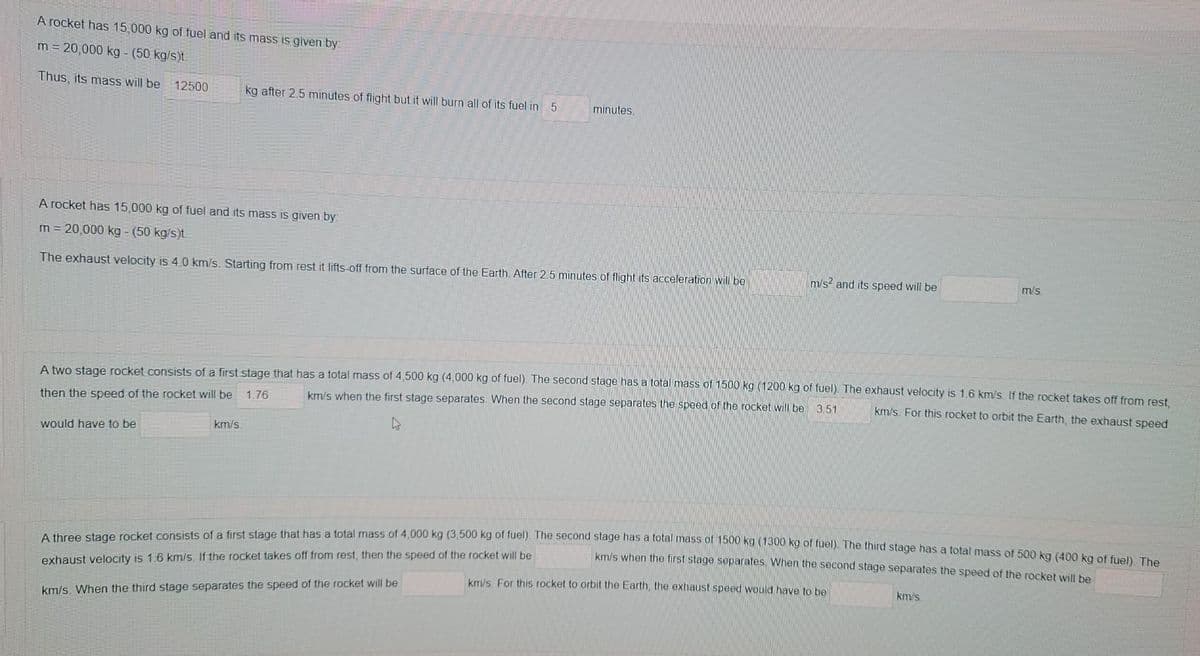A rocket has 15,000 kg of fuel and its mass is given by m = 20,000 kg - (50 kg/s)t Thus, its mass will be 12500 kg after 2.5 minutes of flight but it will burn all of its fuel in 5. minutes. A rocket has 15,000 kg of fuel and its mass is given by m = 20,000 kg - (50 kg/s)t. m/s? and its speed will be m/s The exhaust velocity is 4.0 km/s. Starting from rest it fifts-off from the surface of the Earth, After 2.5 minutes of flight its acceleration will be
A rocket has 15,000 kg of fuel and its mass is given by m = 20,000 kg - (50 kg/s)t Thus, its mass will be 12500 kg after 2.5 minutes of flight but it will burn all of its fuel in 5. minutes. A rocket has 15,000 kg of fuel and its mass is given by m = 20,000 kg - (50 kg/s)t. m/s? and its speed will be m/s The exhaust velocity is 4.0 km/s. Starting from rest it fifts-off from the surface of the Earth, After 2.5 minutes of flight its acceleration will be
Physics for Scientists and Engineers: Foundations and Connections
1st Edition
ISBN:9781133939146
Author:Katz, Debora M.
Publisher:Katz, Debora M.
Chapter10: Systems Of Particles And Conservation Of Momentum
Section: Chapter Questions
Problem 76PQ: A single-stage rocket of mass 308 metric tons (not including fuel) carries a payload of 3150 kg to...
Related questions
Topic Video
Question
1

Transcribed Image Text:A three stage rocket consists of a first stage that has a total mass of 4,000 kg (3,500 kg of fuel). The second stage has a total mass of 1500 kg (1300 kg of fuel). The third stage has a total mass of 500 kg (400 kg of fuel) The
A rocket has 15,000 kg of fuel and its mass is given by:
m = 20,000 kg - (50 kg/s)t.
Thus, its mass will be 12500
kg after 2.5 minutes of flight but it will burn all of its fuel in 5
minutes.
A rocket has 15,000 kg of fuel and its mass is given by:
m = 20,000 kg - (50 kg/s)t.
The exhaust velocity is 4.0 km/s. Starting from rest it lifts-off from the surface of the Earth. After 2.5 minutes of flight its acceleration will be
m/s? and its speed will be
m/s
A two stage rocket consists of a first stage that has a total mass of 4,500 kg (4,000 kg of fuel). The second stage has a total mass of 1500 kg (1200 kg of fuel). The exhaust velocity is 1.6 km/s If the rocket takes off from rest
km/s when the first stage separates. When the second stage separates the speed of the rocket will be
3.51
km/s. For this rocket to orbit the Earth, the exhaust speed
1.76
then the speed of the rocket will be
would have to be
km/s.
km/s when the first stage separates. When the second stage separates the speed of the rocket will be
exhaust velocity is 1.6 km/s. If the rocket takes off from rest, then the speed of the rocket will be
km/s. For this rocket to orbit the Earth, the exhaust speed would have to be
km/s
km/s. When the third stage separates the speed of the rocket will be
Expert Solution
This question has been solved!
Explore an expertly crafted, step-by-step solution for a thorough understanding of key concepts.
This is a popular solution!
Trending now
This is a popular solution!
Step by step
Solved in 3 steps

Knowledge Booster
Learn more about
Need a deep-dive on the concept behind this application? Look no further. Learn more about this topic, physics and related others by exploring similar questions and additional content below.Recommended textbooks for you

Physics for Scientists and Engineers: Foundations…
Physics
ISBN:
9781133939146
Author:
Katz, Debora M.
Publisher:
Cengage Learning

College Physics
Physics
ISBN:
9781305952300
Author:
Raymond A. Serway, Chris Vuille
Publisher:
Cengage Learning

University Physics Volume 1
Physics
ISBN:
9781938168277
Author:
William Moebs, Samuel J. Ling, Jeff Sanny
Publisher:
OpenStax - Rice University

Physics for Scientists and Engineers: Foundations…
Physics
ISBN:
9781133939146
Author:
Katz, Debora M.
Publisher:
Cengage Learning

College Physics
Physics
ISBN:
9781305952300
Author:
Raymond A. Serway, Chris Vuille
Publisher:
Cengage Learning

University Physics Volume 1
Physics
ISBN:
9781938168277
Author:
William Moebs, Samuel J. Ling, Jeff Sanny
Publisher:
OpenStax - Rice University

Principles of Physics: A Calculus-Based Text
Physics
ISBN:
9781133104261
Author:
Raymond A. Serway, John W. Jewett
Publisher:
Cengage Learning

Physics for Scientists and Engineers, Technology …
Physics
ISBN:
9781305116399
Author:
Raymond A. Serway, John W. Jewett
Publisher:
Cengage Learning

College Physics
Physics
ISBN:
9781285737027
Author:
Raymond A. Serway, Chris Vuille
Publisher:
Cengage Learning